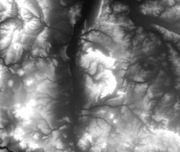Talk:Digital elevation model
(→External links) |
|||
| Line 20: | Line 20: | ||
above a certain level, i.e. a [[Geodetic datum]]. It may represent the [[Wikipedia:Elevation|elevation]] of the bare earth, | above a certain level, i.e. a [[Geodetic datum]]. It may represent the [[Wikipedia:Elevation|elevation]] of the bare earth, | ||
or include objects as buildings or tree canopies <ref name=Liu10> Liu, J. G. & Mason, P. Essential Image Processing and GIS for Remote Sensing. (John Wiley & Sons, 2010).</ref>. | or include objects as buildings or tree canopies <ref name=Liu10> Liu, J. G. & Mason, P. Essential Image Processing and GIS for Remote Sensing. (John Wiley & Sons, 2010).</ref>. | ||
| + | |||
| + | [[Image:Dem_grey.jpg|A DEM (digital elevation model) displayed in grayscale.|thumb|right]] | ||
== Types of DEMs == | == Types of DEMs == | ||
| Line 28: | Line 30: | ||
Still, sometimes both terms are used to describe bare-earth models, leaving the original | Still, sometimes both terms are used to describe bare-earth models, leaving the original | ||
'''Digital elevation model''' term for models including objects above ground level<ref name=Liu10></ref>. | '''Digital elevation model''' term for models including objects above ground level<ref name=Liu10></ref>. | ||
| + | |||
== Creation of DEMs == | == Creation of DEMs == | ||
Revision as of 16:10, 30 May 2013
Contents |
Article discussion
- This section is meant solely for discussion purposes.
For a draft of the article, see #Article draft.
- This section is meant solely for discussion purposes.
Possible contents and links
From Liu & Mason 2010 [1] DGM's are a subgroup of Surface models (should there be an own category?) and can be obtained by
Related articles already existing in this wiki are:
Article draft
- DEM stands for Digital elevation model. It can be represented as a regular grid of points or as a Triangular irregular network of points. DEMs are the basis for digitally produced relief maps.
Digital elevation models are sets of data representing the estimated height of a surface above a certain level, i.e. a Geodetic datum. It may represent the elevation of the bare earth, or include objects as buildings or tree canopies [1].
Types of DEMs
There are no official Definitions of different subgroups of digital elevation models, but the probably most used terms are Digital surface model (DSM) and Digital terrain model (DTM); the first model may quantify the height of the earth including objects on it's surface, while the latter models the elevation of the mere ground. Still, sometimes both terms are used to describe bare-earth models, leaving the original Digital elevation model term for models including objects above ground level[1].
Creation of DEMs
Photogrammetry
- Main article Photogrammetry
Digital elevation models may be obtained by aerial photography and spaceborne instruments such as ASTER, IKONOS or SPOT. The basic principle of photogrammetry is the retrieval of photographs from at least two different positions, which makes the measurement of object heights possible.
Laser Altimetry
- Main article Laser altimetry
Also known as LiDAR, laser altimetry has revolutionized the acquisition of DEM data. LiDAR devices send light pulses to earth and measure the reflection of the ground or objects on it. Time differences between reflected light pulses can be measured, enabling the measurement of object hights.
SAR interferometry
- Main article SAR interferometry
SAR, also referred to as InSAR (Interferometric Synthetic Aperture Radar), provides an acoustic approach to acquire remote sensing data. Acoustic signals are transmitted and the duration of the reflected signal reaching the sensor is measured. An advantage to the optical systems is it's weather independence, as acoustic noise is able to penetrate clouds [1].
DEMs in forestry
Related articles
References
- ↑ 1.0 1.1 1.2 1.3 Liu, J. G. & Mason, P. Essential Image Processing and GIS for Remote Sensing. (John Wiley & Sons, 2010).
